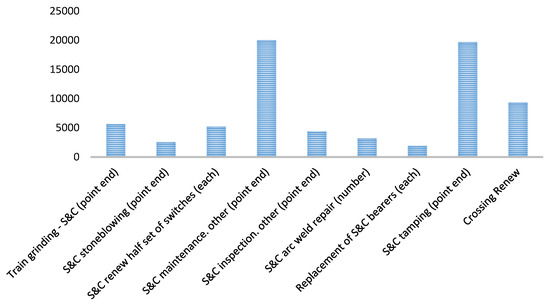A turnout, a component on modern railway tracks, provides operational flexibility by diverting the vehicles to different directions between two routes. A crossing area is a part of turnout where two tracks intersect at a point. At this part, the rail profiles vary along the track and moreover, some of crossing types (i.e., common crossings) have a discontinuity. As a result, high-frequency high impact forces emerge at the crossing area, especially on the crossing nose [1]. Inherently, the repeated forces result in a fatigue problem over turnout crossing noses, which is the root cause of high maintenance costs in railway operations [2]. Most of the studies conducted to date is about the physical phenomena such as environmental effects, material properties, dynamic characteristics of the vehicle/track or management such as maintenance strategies [3,4,5,6,7,8,9]. However, regarding the high costs owing to turnouts in the maintenance budget, an investigation of the problem from an economic aspect is believed to be beneficial for Infrastructure Managers, since it is the top concern for IMs [10].
A common tool for this purpose is the Life-cycle cost analysis (LCC). LCC is an estimate of the total cost from acquisition to disposal of a component or a system. LCC could be categorized under two topics: Simple and Stochastic. The simple analysis is to evaluate the feasibility, which is deterministic and commonly uses an expert’s comment to estimate. On the other hand, a stochastic or complex analysis refers to statistical theories covering also the uncertainties, which is better to decide the cost of whole built-in project. The first step to conduct a life-cycle cost analysis is to create a breakdown work structure. In this study, the breakdown work structure is based on writers’ another paper [11]. In addition to this, the data representing the probabilistic effects while calculating the life-cycle cost is collected from official sources such as Office for National Statistics (see Figure 1).

Figure 1.
LCC analysis based on the breakdown work structure [11].
Several studies addressing the life-cycle cost analysis of a turnout could be found in the literature. However, most of them do not consider the extreme weather events which has an influence on the system resilience [2,12,13,14,15,16]. Writers’ first article on the subject considers this effect; however, it was conducted with a deterministic approach, which was a preliminary study. Therefore, in this study, writers’ aim is to develop their first preliminary work and build a more complicated work. By using stochastic theories (i.e., Bayesian Network), writers believe that the problem is represented more accurately.
Acknowledgments
The first author would like to express his gratitude to the Ministry of National Education (MEB) and ITU for the scholarship. The authors sincerely appreciate the European Commission for the project H2020-“RISEN: Rail Infrastructure Systems Engineering Network”, which provides a global research environment (www.risen2rail.eu) [12].
References
- Kaewunruen, S. Monitoring structural deterioration of railway turnout systems via dynamic wheel/rail interaction. Case Stud. Nondestruct. Test. Eval. 2014, 1, 19–24. [Google Scholar] [CrossRef]
- Nissen, A. LCC analysis for switches and crossings: A case study from the Swedish Railway Network. Int. J. COMADEM 2009, 12, 10–19. [Google Scholar]
- Siew, S.; Mirza, J.O.; Kaewunruen, S. Torsional effect on track-support structures of railway turnouts crossing impact. J. Transp. Eng. Part A Syst. 2016, 143. [Google Scholar] [CrossRef]
- Remennikov, A.M.; Kaewunruen, S. Experimental load rating of aged railway concrete sleepers. Eng. Struct. 2014, 76, 147–162. [Google Scholar] [CrossRef]
- Andersson, C.; Dahlberg, T. Wheel/rail impacts at a railway turnout crossing. Proc. Inst. Mech. Eng. Part F J. Rail Rapid Transit 1998, 212, 123–134. [Google Scholar] [CrossRef]
- Dindar, S.; Kaewunruen, S.; Sussman, J.M. Climate Change Adaptation for GeoRisks Mitigation of Railway Turnout Systems. Procedia Eng. 2017, 189, 199–206. [Google Scholar] [CrossRef]
- Bin Osman, M.H.; Kaewunruen, S.; Jack, A. Optimisation of schedules for the inspection of railway tracks. Proc. Inst. Mech. Eng. Part F J. Rail Rapid Transit 2017, 232. [Google Scholar] [CrossRef]
- Pålsson, B.A. Optimisation of railway crossing geometry considering a representative set of wheel profiles. Veh. Syst. Dyn. 2015, 53, 274–301. [Google Scholar] [CrossRef]
- Kaewunruen, S.; Remennikov, A.M. Sensitivity analysis of free vibration characteristics of an in situ railway concrete sleeper to variations of rail pad parameters. J. Sound Vib. 2006, 298, 453–461. [Google Scholar] [CrossRef]
- EIM-EFRTC-CER. Market Strategy Report—Track Maintenance & Renewal; The Community of European Railway and Infrastructure Companies (CER): Brussels, Belgium, 2012.
- Hamarat, M.; Kaewunruen, S. Life-Cycle Cost Analysis of Railway Turnouts Exposed to Climate Uncertainties. In Proceedings of the The 3rd World Multidisciplinary Civil Engineering—Architecture—Urban Planning Symposium, Prague, The Czech Republic, 18–22 June 2018. [Google Scholar]
- Kaewunruen, S.; Sussman, J.M.; Matsumoto, A. Grand Challenges in Transportation and Transit Systems. Front. Built Environ. 2016, 2, 4. [Google Scholar] [CrossRef]
- Tuler, M.V.; Kaewunruen, S. Life cycle analysis of mitigation methodologies for railway rolling noise and groundbourne vibration. J. Environ. Manag. 2017, 191, 75–82. [Google Scholar] [CrossRef]
- Vitásek, S.; Měšťanová, D. Life Cycle Cost of a Railroad Switch. Procedia Eng. 2017, 196, 646–652. [Google Scholar] [CrossRef]
- Kaewunruen, S.; Sussman, J.M.; Einstein, H.H. Strategic framework to achieve carbon-efficient construction and maintenance of railway infrastructure systems. Front. Environ. Sci. 2015, 3, 6. [Google Scholar] [CrossRef]
- Kaewunruen, S.; Remennikov, A.M. Experimental simulation of the railway ballast by resilient materials and its verification by modal testing. Exp. Tech. 2008, 32, 29–35. [Google Scholar]
Publisher’s Note: MDPI stays neutral with regard to jurisdictional claims in published maps and institutional affiliations. |
© 2018 by the authors. Licensee MDPI, Basel, Switzerland. This article is an open access article distributed under the terms and conditions of the Creative Commons Attribution (CC BY) license (https://creativecommons.org/licenses/by/4.0/).